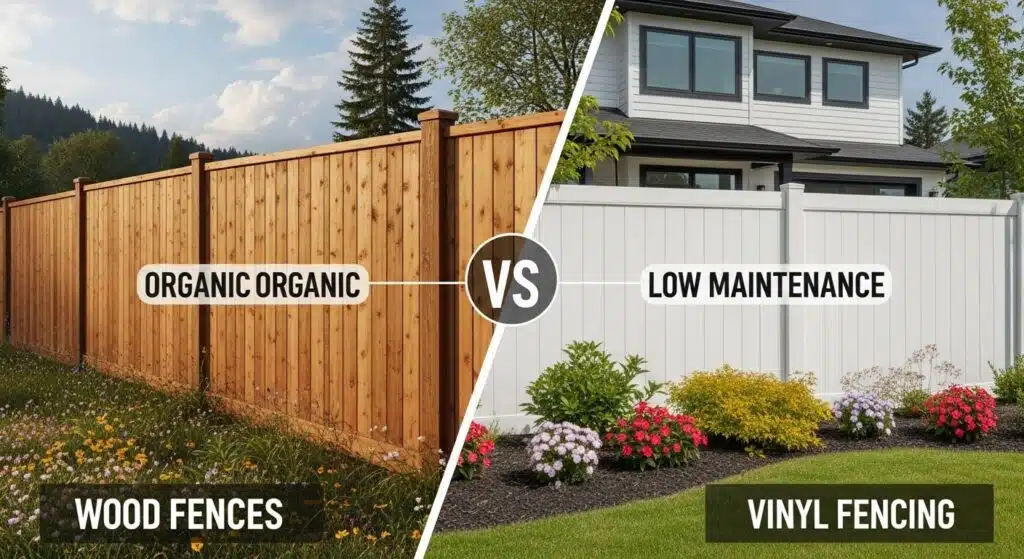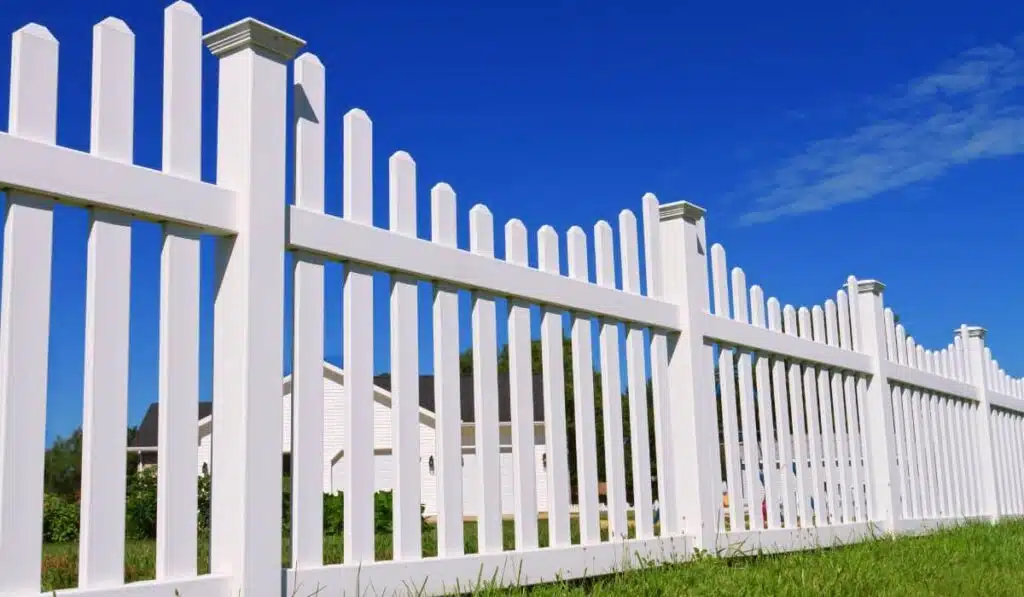
Wood vs. Vinyl Fencing: Durability, Maintenance, and Cost Exposed!
The options when choosing a fence for your property can be overwhelming.
Among the popular choices are wood and vinyl, each offering distinct advantages and considerations.
In this article, we will delve into the durability, maintenance, and cost of wood and vinyl fencing, helping you make an informed decision that best suits your needs and preferences.
Keeping Your Fence Strong
Wood Fencing: Wood fences have been a traditional choice for centuries.
They offer a natural and timeless aesthetic that complements various architectural styles.
However, the durability of wood fencing largely depends on the type of wood used and the environmental conditions it faces.
- Types of Wood: Common types of wood used for fencing include cedar, pine, and redwood.
Cedar and redwood are known for their natural resistance to rot and insects, making them more durable compared to pine.
Pressure-treated wood is also an option, as it undergoes chemical treatment to enhance its resistance to decay and pests.
- Environmental Impact: Wood fence are susceptible to weather conditions.
Prolonged exposure to moisture can lead to rotting, warping, and splitting.
In areas with high humidity or heavy rainfall, wood fences may require frequent maintenance and replacement of damaged sections.
Additionally, wood fences are vulnerable to insect infestations, particularly termites, which can significantly reduce their lifespan.
Vinyl Fencing: Vinyl fencing, also known as PVC fencing, is a relatively modern alternative that has gained popularity for its durability and low maintenance.
Made from synthetic materials, vinyl fences provide several advantages over wood.
- Weather Resistance: Vinyl fences are highly resistant to weather conditions, including moisture, UV rays, and extreme temperatures.
Unlike wood, vinyl does not rot, warp, or split, making it an excellent choice for areas with harsh climates.
- Insect Resistance: Vinyl fences are impervious to insects, eliminating the risk of termite infestations.
This feature contributes to their longevity and reduces the need for frequent repairs or replacements.
Fence Durability That Lasts
Wood Fencing: One significant consideration for wood fencing is the level of maintenance required to keep it in good condition.
- Staining and Sealing: To protect wood fences from moisture and UV damage, regular staining and sealing are necessary.
This process helps maintain the fence’s appearance and extends its lifespan.
Depending on the type of wood and climate, staining and sealing may be required every 2-3 years.
- Repair and Replacement: Wood fences are prone to damage from weather, insects, and physical impact.
Rotting, warping, and splintering are common issues that may require repairs or replacement of affected sections.
Regular inspections and prompt repairs are essential to prevent further damage and maintain the fence’s integrity.
Vinyl Fencing: Vinyl fencing is renowned for its low maintenance requirements, making it an attractive option for homeowners seeking convenience and longevity.
- Cleaning: Vinyl fences are easy to clean and maintain. A simple wash with soap and water is usually sufficient to remove dirt, mold, and mildew. Unlike wood, vinyl does not require staining, sealing, or painting, saving both time and money.
- Longevity: Due to its resistance to weather, insects, and physical damage, vinyl fencing typically requires fewer repairs and replacements than wood fencing. This durability translates to long-term cost savings and reduced maintenance efforts.

Cost
Wood Fencing: The cost of wood fencing can vary significantly based on factors such as the type of wood, fence height, and design.
While wood fences may have a lower initial cost compared to vinyl, it is essential to consider the long-term expenses associated with maintenance and repairs.
- Initial Cost: The initial cost of wood fencing depends on the type of wood chosen. Cedar and redwood are generally more expensive than pine, while pressure-treated wood falls somewhere in between. On average, the cost of wood fencing ranges from $15 to $50 per linear foot, including installation.
- Maintenance Costs: The ongoing maintenance costs for wood fencing can add up over time. Regular staining, sealing, and repairs contribute to the overall expenses. Homeowners should budget for these maintenance tasks to ensure the fence remains in good condition and retains its aesthetic appeal.
Vinyl Fencing: Vinyl fencing typically has a higher upfront cost than wood fencing, but its long-term benefits and lower maintenance requirements can make it a cost-effective choice in the long run.
- Initial Cost: The initial cost of vinyl fencing is generally higher than wood. On average, the price ranges from $20 to $40 per linear foot, including installation. However, this higher upfront investment is offset by the reduced need for maintenance and repairs.
- Maintenance Costs: One of the significant advantages of vinyl fencing is its minimal maintenance requirements. Unlike wood, vinyl does not require staining, sealing, or frequent repairs. This translates to lower long-term maintenance costs and less time spent on upkeep.
Aesthetic Appeal
Wood Fencing: Wood fences offer a natural and classic look that can enhance the aesthetic appeal of any property. Their versatility allows for various design options, including picket, split rail, and privacy fences. Homeowners can also customize wood fences with different stains and finishes to match their preferred style.
- Customization: Wood fences can be easily customized to suit individual preferences. They can be painted or stained in a wide range of colors, allowing homeowners to achieve the desired look for their property. Additionally, wood fences can be shaped and crafted into unique designs, adding a touch of personality and charm.
- Aging and Patina: Over time, wood fences develop a natural patina that can enhance their character and beauty. Some homeowners appreciate the aged look of wood, which adds a rustic and timeless appeal to their property.
Vinyl Fencing: Vinyl fences offer a clean and modern appearance that can complement various architectural styles. While they may not have the same natural charm as wood, vinyl fences are available in a variety of colors and styles to suit different preferences.
- Color Options: Vinyl fences come in a range of colors, including white, beige, gray, and more. Unlike wood, vinyl fences do not require painting or staining, and the color remains vibrant and consistent over time. This feature is particularly appealing to homeowners seeking a low-maintenance and long-lasting fencing solution.
- Design Variety: Vinyl fences are available in various designs, including picket, privacy, and lattice styles. While they may not offer the same level of customization as wood, vinyl fences can still provide an attractive and cohesive look for your property.
Environmental Considerations
Wood Fencing: Wood is a renewable resource, making it an environmentally friendly fencing option. However, the environmental impact of wood fencing depends on its sourcing and treatment.
- Sustainable Sourcing: To minimize environmental impact, it is essential to choose wood from sustainable sources. Look for certifications such as the Forest Stewardship Council (FSC) to ensure the wood is harvested responsibly and supports sustainable forestry practices.
- Chemical Treatments: Pressure-treated wood, while more durable, involves the use of chemicals that can be harmful to the environment. Consider using untreated or naturally resistant wood options to reduce chemical exposure and environmental impact.
Vinyl Fencing: Vinyl fencing is made from synthetic materials, primarily PVC. While vinyl is not biodegradable, it is recyclable, and many manufacturers offer recycling programs for old or damaged vinyl fences.
- Recyclability: Vinyl fences can be recycled, reducing their impact on landfills. When choosing vinyl fencing, inquire about recycling options and consider working with manufacturers that prioritize sustainability.
- Longevity: The long lifespan of vinyl fencing contributes to its environmental benefits. By lasting longer and requiring fewer replacements, vinyl fences reduce the demand for new materials and minimize waste.
Conclusion
Choosing between wood and vinyl fencing depends on your priorities.
Wood offers a classic, customizable look but requires regular maintenance and is susceptible to weather and insect damage.
Vinyl, while more expensive initially, provides superior durability, low maintenance, and resistance to the elements.
If you value a traditional aesthetic and are prepared for upkeep, wood fencing is a great choice.
For those prioritizing long-term savings and minimal maintenance, vinyl is ideal.
Consider your needs and budget to make the best decision for your property.
For more information or to start your fencing project, contact us at Bravo Fence Company today!
FAQs
How durable is wood fencing compared to vinyl fencing?
Wood fences are durable, but their lifespan depends on the wood and environmental conditions. Cedar and redwood are naturally resistant to rot and insects, while pressure-treated wood enhances resistance to decay and pests. Vinyl fencing is highly durable, resistant to weather conditions, and impervious to insects, making it a long-lasting choice.
What types of wood are commonly used for fencing?
Common types of wood used for fencing include cedar, pine, and redwood. Cedar and redwood are known for their natural resistance to rot and insects, whereas pine is less durable but more affordable.
Are vinyl fences resistant to weather and insects?
Yes, vinyl fences are highly resistant to various weather conditions, including moisture, UV rays, and extreme temperatures. They do not rot, warp, or split and are also impervious to insects, eliminating the risk of termite infestations.
How much maintenance does a wood fence require?
Wood fences require regular maintenance, including staining and sealing every 2-3 years to protect against moisture and UV damage. Regular inspections and repairs are also necessary to address issues like rotting, warping, and splintering.
What kind of maintenance is needed for a vinyl fence?
Vinyl fences are low-maintenance. They can be easily cleaned with soap and water to remove dirt, mold, and mildew. Unlike wood, vinyl does not require staining, sealing, or painting.
Tags: Complete Guide to Maintenance Of Vinyl Fences, Everything You Need to Know About Lifespan Of Wood Fences, Everything You Need to Know About Wood Fencing Styles, Explore Helpful Resources on Cost Comparison Wood Vs Vinyl Fencing, Explore Helpful Resources on Durability Of Wood Fences, Explore Helpful Resources on Vinyl Fencing Installation, Inspiration and Tips on Aesthetic Appeal Of Wood Fencing, Inspiration and Tips on Environmental Impact Of Vinyl Fences, Inspiration and Tips on Privacy Fencing Options, Inspiration and Tips on Weather Resistance Wood Vs Vinyl, Top Ideas and Insights About Vinyl Fencing Advantages, Top Ideas and Insights About Wood Fencing Benefits

